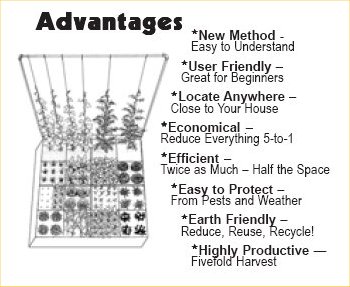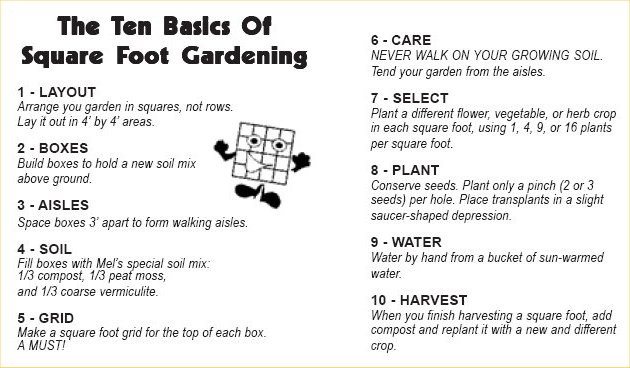Square foot gardening
From Allotments4All
A method of gardening introduced by Mel Bartholomew.
http://www.squarefootgardening.com/
If you have a pocket handkerchief garden, or are a novice vegetable grower, why not try gardening in a 4ft x 4ft square? This is all the space you need to start a square foot garden, explains Colin Shaw who is adapting this high input technique to organic growing, with trial plots at Ryton and in his own garden.
How much can you grow in a bed measuring 4ftx4ft (1.2mx1.2m)? You may be surprised by the results claimed for the 'Square Foot' gardening technique imported from the US. The idea was developed about 20 years back by Mel Bartholomew and his claims are impressive. A typical bed can contain everything from leeks to lettuce, even allowing some space for attractant plants.
A raised and edged bed 4ftx4ft is made and subdivided into 1ft squares. Each square is planted with a different crop using very close spacing. Throughout the growing season, as soon as each crop is finished it is replaced by a different one. Plants are grown so that the tallest are at the back, with sizes decreasing progressively towards the front of the bed. The bed should face south for maximum sunlight.
The original technique was based on beds with a premixed artificial 'soil'. The idea was to create the best possible growing medium with little effort. Mel Bartholomew also used a fairly rich balanced fertiliser. Although he did not follow the principles of organic growing, the overall idea is not far removed from the close spacing and intensive growing used by organic gardeners.
During the 1998 season I have been managing two trial beds in my own garden and one at in the Ryton Garden at Garden Organic’s Ryton (then HDRA) headquarters. Converting the square foot gardening method to organic growing did not look difficult, as a good healthy soil should support this kind of intensive growing. All the beds have been planted in accordance with the principles that Mel laid down in his book. So far the results look promising, apart from the massive slug problem this season and a plague of rabbits at Ryton.
It might seem important to use small varieties of plants at such close spacing, but this is not the case. Trials with mini lettuce and traditional varieties like Webbs Wonderful, Salad Bowl, Frisby and Cochade have shown that it is perfectly feasible to use standard varieties. My own preference is for 'cut and come again' lettuce like Salad Bowl or Frisby. Five Salad Bowl in a 1ft square on one of my trial beds provided a continuous supply of lettuce for several weeks. At Ryton we grew four Frisby in a square foot and they also performed well, taking up less space than Salad Bowl.
Rotating friends and foes
Rotation is crucial in organic gardens both in terms of pest management and to prevent nutrient depletion, and the square foot bed is no exception. Having 16 distinct growing areas would appear to make crop rotation easy. Mel argues that when a crop is finished all that is required is to replace it with something different, producing an automatic, 'natural' crop rotation. I do not think it is as easy as that, however. Square foot gardeners will need to use good rotation practices. The position is further complicated by the need to grow tall plants at the rear of the bed as this places a restriction on the rotation plan.
There is a similar problem with companion planting. With so many different plants in such a small area, there is a maximum of 3ft between any two plant groups. This is fine for plants that like to be close to their friends but it also means they can be no more than 3ft away from their foes! My own trials suggest that this is not a big problem. However, Dwarf French beans planted next to a square of onions did not do well, while another square of beans 2ft from the onions thrived.
Rethink your techniques Planting methods and bed management need a complete rethink when you are gardening on such a small scale. Some Square Foot Gardening techniques can be transferred to the conventional garden. Planting long rows of seeds and subsequent thinning can be an irksome task. Not only are more than half the seeds wasted, but the time and effort required seems counter-productive. The technique suggested for square foot beds is "station sowing". It is a simple process. A dibber is used to make a small hole of the required depth at the spacing needed by the mature plant. Seeds are dropped into the hole which is then filled with fine soil. For most plants 1-2 seeds are sufficient, but for carrots and parsnips I used 4-5 seeds to ensure uniform germination. If more than one seed germinates, those not required are simply snipped off with a pair of scissors, rather than pulled out, to avoid disturbing the roots of the remaining plant.
The proof of the pudding... The Square Foot Gardening method has a lot to offer the organic gardener. It is a very economical way of using small patches of ground to grow the maximum amount of different crops. It is also an IDEAL way to start vegetable growing, as a new gardener does not need to make huge investments in time, space, seeds and tools to achieve good results. One of my neighbours has been tempted to have a go at growing vegetables for the first time, and she found that digging up a small patch of lawn was not so daunting as making a larger bed. The reward was the sheer joy and enthusiasm when she harvested her first organic lettuce.
Taken from issue 153 of The Organic Way (HDRA News) 1998 - written by Colin Shaw and (updated 2005)



